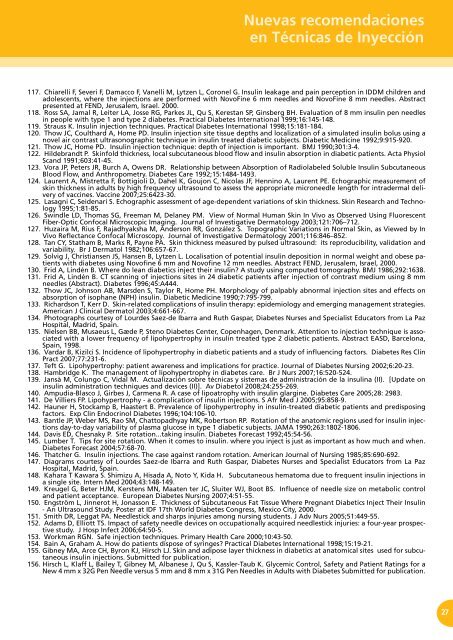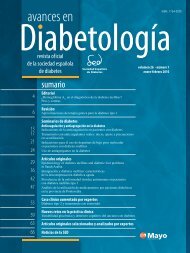libro-bd-medical
libro-bd-medical
libro-bd-medical
You also want an ePaper? Increase the reach of your titles
YUMPU automatically turns print PDFs into web optimized ePapers that Google loves.
Nuevas recomendaciones<br />
en Técnicas de Inyección<br />
117 Chiarelli F, Severi F, Damacco F, Vanelli M, Lytzen L, Coronel G. Insulin leakage and pain perception in IDDM children and<br />
adolescents, where the injections are performed with NovoFine 6 mm needles and NovoFine 8 mm needles. Abstract<br />
presented at FEND, Jerusalem, Israel. 2000.<br />
118 Ross SA, Jamal R, Leiter LA, Josse RG, Parkes JL, Qu S, Kerestan SP, Ginsberg BH. Evaluation of 8 mm insulin pen needles<br />
in people with type 1 and type 2 diabetes. Practical Diabetes International 1999;16:145-148.<br />
119 Strauss K. Insulin injection techniques. Practical Diabetes International 1998;15:181-184.<br />
120 Thow JC, Coulthard A, Home PD. Insulin injection site tissue depths and localization of a simulated insulin bolus using a<br />
novel air contrast ultrasonographic technique in insulin treated diabetic subjects. Diabetic Medicine 1992;9:915-920.<br />
121 Thow JC, Home PD. Insulin injection technique: depth of injection is important. BMJ 1990;301:3-4.<br />
122. Hildebrandt P. Skinfold thickness, local subcutaneous blood flow and insulin absorption in diabetic patients. Acta Physiol<br />
Scand 1991;603:41-45.<br />
123 Vora JP, Peters JR, Burch A, Owens DR. Relationship between Absorption of Radiolabeled Soluble Insulin Subcutaneous<br />
Blood Flow, and Anthropometry. Diabetes Care 1992;15:1484-1493.<br />
124 Laurent A, Mistretta F, Bottigioli D, Dahel K, Goujon C, Nicolas JF, Hennino A, Laurent PE. Echographic measurement of<br />
skin thickness in adults by high frequency ultrasound to assess the appropriate microneedle length for intradermal delivery<br />
of vaccines. Vaccine 2007;25:6423-30.<br />
125 Lasagni C, Seidenari S. Echographic assessment of age-dependent variations of skin thickness. Skin Research and Technology<br />
1995;1:81-85.<br />
126 Swindle LD, Thomas SG, Freeman M, Delaney PM. View of Normal Human Skin In Vivo as Observed Using Fluorescent<br />
Fiber-Optic Confocal Microscopic Imaging. Journal of Investigative Dermatology 2003;121:706–712.<br />
127 Huzaira M, Rius F, Rajadhyaksha M, Anderson RR, González S. Topographic Variations in Normal Skin, as Viewed by In<br />
Vivo Reflectance Confocal Microscopy. Journal of Investigative Dermatology 2001;116:846–852.<br />
128 Tan CY, Statham B, Marks R, Payne PA. Skin thickness measured by pulsed ultrasound: its reproducibility, validation and<br />
variability. Br J Dermatol 1982;106:657-67.<br />
129 Solvig J, Christiansen JS, Hansen B, Lytzen L. Localisation of potential insulin deposition in normal weight and obese patients<br />
with diabetes using Novofine 6 mm and Novofine 12 mm needles. Abstract FEND, Jerusalem, Israel, 2000.<br />
130 Frid A, Lindén B. Where do lean diabetics inject their insulin? A study using computed tomography. BMJ 1986;292:1638.<br />
131 Frid A, Lindén B. CT scanning of injections sites in 24 diabetic patients after injection of contrast medium using 8 mm<br />
needles (Abstract). Diabetes 1996;45:A444.<br />
132 Thow JC, Johnson AB, Marsden S, Taylor R, Home PH. Morphology of palpably abnormal injection sites and effects on<br />
absorption of isophane (NPH) insulin. Diabetic Medicine 1990;7:795-799.<br />
133 Richardson T, Kerr D. Skin-related complications of insulin therapy: epidemiology and emerging management strategies.<br />
American J Clinical Dermatol 2003;4:661-667.<br />
134 Photographs courtesy of Lourdes Saez-de Ibarra and Ruth Gaspar, Diabetes Nurses and Specialist Educators from La Paz<br />
Hospital, Madrid, Spain.<br />
135 Nielsen BB, Musaeus L, Gæde P, Steno Diabetes Center, Copenhagen, Denmark. Attention to injection technique is associated<br />
with a lower frequency of lipohypertrophy in insulin treated type 2 diabetic patients. Abstract EASD, Barcelona,<br />
Spain, 1998.<br />
136. Vardar B, Kizilci S. Incidence of lipohypertrophy in diabetic patients and a study of influencing factors. Diabetes Res Clin<br />
Pract 2007;77:231-6.<br />
137 Teft G. Lipohypertrophy: patient awareness and implications for practice. Journal of Diabetes Nursing 2002;6:20-23.<br />
138 Hambridge K. The management of lipohypertrophy in diabetes care. Br J Nurs 2007;16:520-524.<br />
139 Jansà M, Colungo C, Vidal M. Actualización sobre técnicas y sistemas de administración de la insulina (II). [Update on<br />
insulin administration techniques and devices (II)]. Av Diabetol 2008;24:255-269.<br />
140 Ampudia-Blasco J, Girbes J, Carmena R. A case of lipoatrophy with insulin glargine. Diabetes Care 2005;28: 2983.<br />
141 De Villiers FP. Lipohypertrophy - a complication of insulin injections. S Afr Med J 2005;95:858-9.<br />
142 Hauner H, Stockamp B, Haastert B. Prevalence of lipohypertrophy in insulin-treated diabetic patients and predisposing<br />
factors. Exp Clin Endocrinol Diabetes 1996;104:106-10.<br />
143 Bantle JP, Weber MS, Rao SM, Chattopadhyay MK, Robertson RP. Rotation of the anatomic regions used for insulin injections<br />
day-to-day variability of plasma glucose in type 1 diabetic subjects. JAMA 1990;263:1802-1806.<br />
144 Davis ED, Chesnaky P. Site rotation...taking insulin. Diabetes Forecast 1992;45:54-56.<br />
145 Lumber T. Tips for site rotation. When it comes to insulin. where you inject is just as important as how much and when.<br />
Diabetes Forecast 2004;57:68-70.<br />
146 Thatcher G. Insulin injections. The case against random rotation. American Journal of Nursing 1985;85:690-692.<br />
147 Diagrams courtesy of Lourdes Saez-de Ibarra and Ruth Gaspar, Diabetes Nurses and Specialist Educators from La Paz<br />
Hospital, Madrid, Spain.<br />
148 Kahara T Kawara S. Shimizu A, Hisada A, Noto Y, Kida H. Subcutaneous hematoma due to frequent insulin injections in<br />
a single site. Intern Med 2004;43:148-149.<br />
149. Kreugel G, Beter HJM, Kerstens MN, Maaten ter JC, Sluiter WJ, Boot BS. Influence of needle size on metabolic control<br />
and patient acceptance. European Diabetes Nursing 2007;4:51-55.<br />
150 Engström L, Jinnerot H, Jonasson E. Thickness of Subcutaneous Fat Tissue Where Pregnant Diabetics Inject Their Insulin<br />
- An Ultrasound Study. Poster at IDF 17th World Diabetes Congress, Mexico City, 2000.<br />
151 Smith DR, Leggat PA. Needlestick and sharps injuries among nursing students. J Adv Nurs 2005;51:449-55.<br />
152 Adams D, Elliott TS. Impact of safety needle devices on occupationally acquired needlestick injuries: a four-year prospective<br />
study. J Hosp Infect 2006;64:50-5.<br />
153 Workman RGN. Safe injection techniques. Primary Health Care 2000;10:43-50.<br />
154 Bain A, Graham A. How do patients dispose of syringes? Practical Diabetes International 1998;15:19-21.<br />
155. Gibney MA, Arce CH, Byron KJ, Hirsch LJ. Skin and adipose layer thickness in diabetics at anatomical sites used for subcutaneous<br />
insulin injections. Submitted for publication.<br />
156. Hirsch L, Klaff L, Bailey T, Gibney M, Albanese J, Qu S, Kassler-Taub K. Glycemic Control, Safety and Patient Ratings for a<br />
New 4 mm x 32G Pen Needle versus 5 mm and 8 mm x 31G Pen Needles in Adults with Diabetes Submitted for publication.<br />
27



